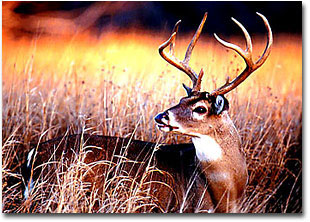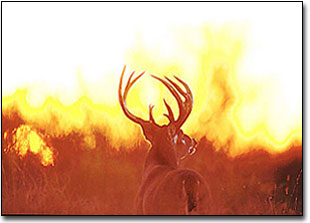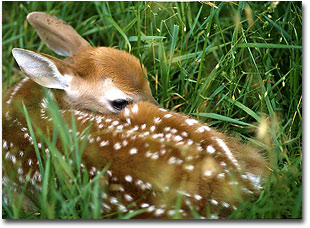 Recent Forum threads have explored why many of the participants at NPN like to photograph birds. While this camera hunter does too - as evidenced by my books on common loons and bald eagles - furry creatures make me want to burn film the most. And so it seems appropriate to get some of you birdbrains thinking about them as well. Just kidding!! There have been lots of great mammal images on these Forums too. For this month's column, let's explore one of the most challenging of targets for the camera hunter- the white-tailed deer. The Mooseman
Recent Forum threads have explored why many of the participants at NPN like to photograph birds. While this camera hunter does too - as evidenced by my books on common loons and bald eagles - furry creatures make me want to burn film the most. And so it seems appropriate to get some of you birdbrains thinking about them as well. Just kidding!! There have been lots of great mammal images on these Forums too. For this month's column, let's explore one of the most challenging of targets for the camera hunter- the white-tailed deer. The Mooseman
What do you know about white-tailed deer?
Do you know that they live in each of the lower 48 states, as well as in 8 Canadian Provinces? That many hunters consider the whitetail to be the most challenging game in North America? That while most whitetails will run at the sight of a human, you can get close enough to them for some great photographs?
Deer Foods
I've written in this column before, one of the most important things that you should know about any given species that you hope to photograph, is what and when they eat. Why? Think about it-if you were an alien from space who came to Earth to photograph humans, what would be one of the best ways to find them? Go to a fast food restaurant at noon, right?
What do deer eat? It depends upon where they live and what the current season is. Whitetails in different parts of North America have different food preferences. I once photographed a Texas whitetail eating a prickly pear cactus, a plant that I'll bet his Maine cousins would walk right past!
Some favorite deer foods include acorns, apples, clover, corn, grasses, forbs and a wide variety of browse foods - the tender twig ends, buds and leaves of shrubs and trees. Since browse species vary so widely with geography, you need to consider most anything a possible food for deer, even the ornamental shrubs around your house! Look for deer food sources when you scout the area where you plan to camera hunt.
Also, keep in mind to look for deer signs, including nipped branch ends from feeding, as well as pellet piles and bedding sites, and of course, tracks.
Camera Concerns

Now let's consider some equipment needs for camera hunting whitetails. The ideal equipment includes:
- a 35mm camera with automatic frame advance
- a 400mm or longer telephoto lens, as "fast" as you can afford
- a shorter lens in the 200mm range; a zoom can be ideal
- a sturdy tripod that is not shiny silver metal, with a smooth panning head (if your
tripod is not anodized black or dull gray, consider covering the legs with
camouflage tape)
- a camouflage cloth blind that is easily carried, to use where permitted. Note that
some parks and refuges do not permit the use of blinds. Always ask if in doubt.
Blinds should also be used with great care near areas where hunting is permitted.
You might also want to check to see if the park or refuge may have provided blinds for wildlife viewing and photography, as the managers of these places often know where the best opportunities to see different animals can occur.
What if you can't afford a long telephoto lens? You can still get some great photographs of deer. It really depends on what kind of photographs you want and how much time and energy you're willing to put into it.
Deer Behavior
All deer have an excellent sense of sight, a well-developed sense of smell and an incredible sense of hearing. To paraphrase a Native American saying: "A leaf falls in the forest-the eagle sees it, the bear smells it and the deer hears it."
Wind direction definitely matters when you work whitetails. You need to keep your scent away from them. Their excellent sense of smell permits them to detect danger, perhaps up to 1/2 a mile away when the wind is to their advantage
 A deer won't spot you if you're camouflaged, don't move and it won't smell you, if you have the wind advantage. However, if you make a sound, it will either run or approach to investigate the source. Unnatural sounds often make a deer approach, while sounds a predator makes, such as the snap of a twig, are apt to frighten it away. The click of a shutter usually makes a wary whitetail stop and stand perfectly still as it tries to figure out the source of the unnatural sound. If a deer cannot discern the source for such a sound, it often comes closer. The camera hunter who stays well hidden and shoots without showing any movement can get some great images! That is one reason why you want automatic frame advance - you don't want to show any motion when a whitetail is watching.
A deer won't spot you if you're camouflaged, don't move and it won't smell you, if you have the wind advantage. However, if you make a sound, it will either run or approach to investigate the source. Unnatural sounds often make a deer approach, while sounds a predator makes, such as the snap of a twig, are apt to frighten it away. The click of a shutter usually makes a wary whitetail stop and stand perfectly still as it tries to figure out the source of the unnatural sound. If a deer cannot discern the source for such a sound, it often comes closer. The camera hunter who stays well hidden and shoots without showing any movement can get some great images! That is one reason why you want automatic frame advance - you don't want to show any motion when a whitetail is watching.
Deer make many body language signals to each other. They display signs of aggression, alarm, fear and other "feelings" that you need to recognize if you're trying to get closer for a photo opportunity.
A twitching tail indicates normalcy as deer feed. Feeding deer often look up to check for danger, then flick their tail before returning to feeding.
A raised and flared tail says a deer is concerned about something it senses in the area. Other deer seeing this signal will be on the alert as well. If you move or make any noise, they will probably explode into motion. Don't even blink! If the deer giving the alarm sign goes back to normal behavior, wait until any others in sight relax as well.
A foot stomp also signals alarm. And it often leaves an unseen message: a hard stomping deer leaves an alarm scent from glands in its hooves. Waiting for another deer to pose at that site is probably a waste of time.
Deer also make a variety of vocalizations to communicate to each other. These include:
- the grunt, a low-pitched, guttural "hello" sound made by bucks
- the blat, a similar, higher pitched "hello" sound made by does
- the bleat, a high pitched call made by fawns to their mothers
- the snort, an explosive sound of alarm or surprise
- the scream/snort -a definite danger alert that makes deer run
Spend some time with whitetails and you'll hear these calls and more.
Learn to interpret them and other behaviors of whitetails and you'll gain fascinating insight into the lives of deer and become a better camera hunter.
Catch yours in the good light.
BS-NPN 012
http://camerahunter.com
Comments on Bill Silliker, Jr.'s The Camera Hunter articles? Send them to the editor.
Maine wildlife & nature photographer Bill Silliker, Jr. – The Mooseman - photographed at many wild places in North America, with the results published in magazines internationally and in 9 of his own books. Bill was an instructor of wildlife and nature photography for L. L. Bean's Outdoor Discovery Program and a member of the Fuji Film Talent Team. Read more about Bill on the Camera Hunter archives page.



